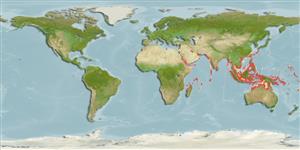Elasmobranchii (haaien en roggen) (sharks and rays) >
Carcharhiniformes (Ground sharks) >
Carcharhinidae (Requiem sharks)
Etymology: Rhizoprionodon: rhiza (Gr.), root; prion (Gr.) saw; odon (Gr.), tooth, referring to teeth with serrated (saw-like) bases, or roots [replacement name for Rhizoprion Ogilby 1915, preoccupied by Rhizoprion Jourdan 1861 in mammals]. (See ETYFish); oligolinx: Per Springer, Greek for “short furrow,” referring to short upper labial furrow. (See ETYFish).
Environment: milieu / climate zone / depth range / distribution range
Ecologie
marien rifbewoner; diepte 0 - 36 m (Ref. 9997). Tropical; 30°N - 18°S
Indo-West Pacific: Persian Gulf east to Thailand, Indonesia, China, and Japan. Recorded from the Gulf of Carpentaria (Ref. 6871) and Palau (Ref. 244). This species is very close to Rhizoprionodon taylori, but is geographically separated from it (Ref. 244).
Lengte bij maturiteit / Grootte / Gewicht / Leeftijd
Maturity: Lm 43.2, range 32 - 65 cm
Max length : 84.5 cm TL mannelijk / geslacht onbekend; (Ref. 121648); 77.5 cm TL (female); max. gepubliceerd gewicht: 2.8 kg (Ref. 121648)
Dorsale stekels (totaal) : 0; Anale stekels: 0. Position of anal fin origin well in front of second dorsal fin origin, long labial furrows, and short pectoral fins (Ref. 37816).
A little known inshore and offshore shark found on continental and insular shelves (Ref. 244). Found to depths of at least 36 m (Ref. 9997). Probably feeds on fishes, cephalopods, and crustaceans (Ref. 6871). Viviparous (Ref. 50449). Commonly caught by inshore demersal gillnet fisheries, especially off Java (Ref.58048). Utilized fresh and probably dried salted for human consumption (Ref. 244). Also used for fishmeal (Ref. 9997) and fins (Ref.58048). Minimum depth from Ref. 58018.
Viviparous, placental (Ref. 50449). With 3 to 5 young per litter (Ref. 244, 37816). Size at birth 20-30 cm TL (Ref. 9997, 37816). Distinct pairing with embrace (Ref. 205).
Compagno, L.J.V., 1984. FAO Species Catalogue. Vol. 4. Sharks of the world. An annotated and illustrated catalogue of shark species known to date. Part 2 - Carcharhiniformes. FAO Fish. Synop. 125(4/2):251-655. Rome: FAO. (Ref. 244)
Status op de Rode Lijst van het IUCN (Ref. 130435)
Gevaar voor de mens
Harmless
Gebruik door de mens
Visserij: commercieel
Tools
Speciale rapporten
Download XML
Internetbronnen
Estimates based on models
Preferred temperature (Ref.
123201): 26.2 - 29.3, mean 28.6 °C (based on 2593 cells).
Fylogenetische diversiteitsindex (Ref.
82804): PD
50 = 0.5078 [Uniqueness, from 0.5 = low to 2.0 = high].
Bayesian length-weight: a=0.00331 (0.00264 - 0.00415), b=3.08 (3.04 - 3.12), in cm total length, based on LWR estimates for this species (Ref.
93245).
Trofisch niveau (Ref.
69278): 4.1 ±0.55 se; based on food items.
Generation time: 2.3 ( na - na) years. Estimated as median ln(3)/K based on 1
growth studies.
Weerstandsvermogen (Ref.
120179): Zeer laag, minimale populatieverdubbelingstijd meer dan 14 jaar (Fec=2).
Fishing Vulnerability (Ref.
59153): Moderate vulnerability (45 of 100).
